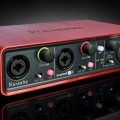Picking up a thread from earlier where I described how to optimize audio latency from a more general perspective, I will now try to convey some of my best practical tips for battling audio latency in Reaper – especially in conjunction with VST amp sims.
I’ve actually done away with all physical amps and multieffect pedals, in favor of just an audio interface, Reaper and real-time amp sims. It’s extremely versatile, very space-efficient (haha) and suits me perfectly, but it took a bit of tuning to get it to work.
The most important thing to get low latency without crackling is to keep CPU use in control. Sometimes the problem isn’t latency at all – but an overloaded CPU still produces bad output because it can’t cope.
1. Use what you need
Most plugins, especially amp sims, have settings for quality and stereo. If you are running plugins on a single mono track, make sure that you switch them to mono. This will actually save a lot of CPU consumption. While you are recording, you can also switch the quality setting to “low” or “2x oversample” instead of “8x” etc if your CPU is on its knees – you can always switch it back to high quality when mixing or rendering, since that usually consumes less processor power than recording and monitoring – and is also less sensible to latency.
Another very important issue is to switch off any plugins not needed for recording. It’s very easy to forget that say a mastering plugin like Ozone is active on the master track – that will immediately make live monitoring recording impossible.
2. Reuse what you can
If you are double tracking guitars and using two mono tracks hard panned to left and right with individual but identical amp sims, you can route those two tracks through a parent track with just one instance of each plugin in stereo mode. As long as you pan 100% to left and right, plugins like LePou’s amp sims will behave like two separate instances.
4. Stop FX from running when idle
I noticed that Reaper was running at over 30% CPU while doing nothing as soon as I would have a project open. After some investigating I came across a setting that prevents VST from running when there is no playback. You’d think that a non-playing VST would consume no resources, but apparently not. This won’t actually help you with latency or CPU overload, but it will help your computer a lot cooler. You can find the setting in preferences under Audio > Playback.
5. Last resort: freeze tracks
If you apply all your tricks and still don’t have enough free processing power to record or playback without problems, you can freeze the tracks you’re not working on. Just right-click the track and freeze.
I’d like to issue a word of caution though – at least once after a lot of editing with splitting and moving things around on a MIDI track, it couldn’t be unfrozen. So since then, I prefer rendering the track to a stem on a separate track and leave the original intact but mute.
More tips
The Reaper wiki has an excellent article that focuses more on audio latency related to the audio interface itself.
As always, share your own best tips in the comments and good luck!



